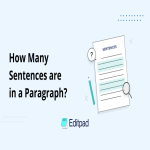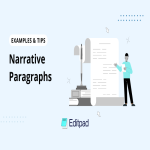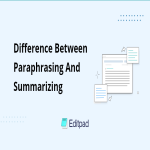Biggest Launch
Introducing Our New
API's
- Available Today
Summarizing and paraphrasing are two techniques that can be used for different purposes. For example, you can summarize a piece of text if you want to make it a little shorter for your audience. On the other hand, you can paraphrase some content if you want to improve the flow and clarity.

Now, since these two are both the names of techniques (and they are both used in writing), it can be a little confusing to know how exactly they’re different.
In this blog post, we will be looking at some of the main differences between these two. To make the whole concept clearer, we will also show some examples using sample text.
In the words of Merriam-Webster, the definition of summarizing is as follows:
“…to tell in or reduce to a summary…”
Of course, this itself is not very descriptive. To understand the definition a bit better, we have to understand what a summary is itself. And for that, the following answer is provided by Merriam-Webster:
“…an abstract, abridgment, or compendium especially of a preceding discourse…”
De-cluttering the complexity a little, we can understand a summary to be a shortened form of a piece of content.
The process of summarizing means shortening something in such a way that the main points are encapsulated.
Considering the definition that we’ve provided above, here are some examples of summarizing that can help you understand the concept a little better:
“It was around noon that the rider reached the village, waving the red cloth in this hand. His horse bore the marks of the long journey. Dusty and bedraggled, his eyes were puffy, hair drooping, and clothing torn in places.
The red cloth he had in his hand was wet, and it looked as though soaked in blood. The rider, along with the red cloth, made a terrifying sight. The children playing in the street cried in horror and ran back to their homes.
The frightful look for the rider was compounded by the woebegone appearance of his horse. His neck was drooped, and his fetlocks were dusty.
The people came outside, enquiring: Is there an invading army that you warn us of? Is our village going to be raided or attacked? No, he replied, this is merely a rag that my mother told me to dry. Waving makes it dry faster. Shaking their heads, the people went back to their homes.”
Here is the summary of the above passage:
“When the frightening and tired rider reached the village waving the red cloth, he said he was only drying it when the people asked him if it was the signal of an impending attack.”
Here is a slightly shorter example:
“The man got the banana from the shop. He haggled a little with the shopkeeper about the price. The haggling escalated into shouting and yelling, culminating in the man emerging from the shop and scurrying with the banana in hand. He peeled it and then threw away the skin in the garbage. The peel bounced back in his path, causing him to slip.”
Here is the summary of the above:
“The man got a banana from the shop with much difficulty, and he slipped on the peel that he removed from it.”
The main idea of summarizing is to shorten a piece of text. However, to achieve this, there are a number of different steps that can be utilized.

Here are some points of summarization:
While we’re discussing these steps, it’s prudent to mention the two main types of summaries, i.e., abstractive and extractive.
For example, if this is a passage that has to be summarized using the abstractive technique, here is what the output would be:
Original text | Summarized text |
There was a wolf prowling around the yard. The boy could not understand how it had scaled the wall, which happened to be 10 feet tall. It was not until he had stared around for 10 minutes that he realized that the front gate was wide open, and more wolves were entering through it by the second. | The boy was confused about how the wolf had entered the yard that had a tall wall around it. He then saw more wolves entering through the main gate, which was wide open. |
Here is an example of what extractive summarization can look in action:
Original Text | Summarized Text |
There was a banana on the shelf. Jeff looked at the banana on the shelf. He then asked the shopkeeper the price of the banana. Then, he picked up the banana. He then bought the banana. He then ate the banana. | There was a banana on the shelf. He then bought the banana. He then ate the banana. |
So, coming back to the point, depending on which type of summarizing you’re trying to do, the whole process could either be very simple and short or it could be long and complex.
For example, if you are writing an extractive summary, then you will just need to scan the content once and then pick out the most meaningful sentences from the lot. On the other hand, if you are writing an abstractive summary, then you will need to read the content through and then use your own words to convey the main concept.
Editpad's text summarizer also does the same thing to write summaries, as you can see an example in the image below:
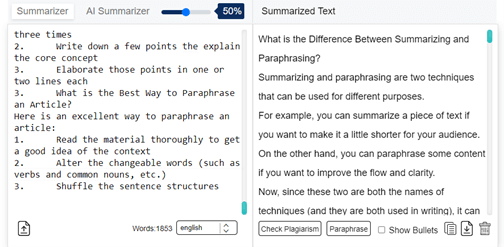
Summarizing is a useful skill that is required in different situations and instances. To name a few, here are some uses of summarizing.
Now that we’re done looking at what summarizing is and how you can do it, let’s move on to paraphrasing.
Although we are talking about these two techniques together, they are not actually very similar. Other than being two techniques that you can apply to your content, they’re not that alike.

For one, summarizing is the process of shortening a piece of content while keeping the main idea and context intact. But, if we look at what paraphrasing is defined, we’ll see that it is something quite different.
Gleaning from the above definition, we can understand that paraphrasing can be defined as the process of rewording a piece of content in order to change the way it looks while having it convey the same meaning.
Now that we’re done looking at "what is paraphrasing", let’s move on to look at some examples.
As we did above, the purpose of giving examples is to help you understand the concept better, something which is a lot easily done with an actual demonstration.
Here is a sentence that we will paraphrase.
“There was a lot of smoke in the room, which appeared to be coming out of the malfunctioning smoke machine.”
Paraphrased version: The malfunctioning smoke machine had filled the room with smoke.
Now, from the above, there is a little point that we can understand. And that is: summarizing can sometimes be a part of paraphrasing and paraphrasing can sometimes be a part of summarizing, but they’re not actually the same thing.
When writing a summary, you can be required to make a few changes to the words of the original content. (That is, of course, if you are writing an extractive summary.)
These changes can be, in a way, interpreted to be paraphrasing. Similarly, when you’re paraphrasing something, you’ll find yourself shortening a few phrases and clauses here and there.
These changes can also be, in a way, interpreted to be summarizing.
While paraphrasing and summarizing are two different things, there is a little bit of both in each other.
Here are a couple of other examples of paraphrasing:
There were nine elephants in the room when the boy walked in. It took one terrified scream of the nine-year-old to set off the trumpeting of the nine-tusked mammals.
Paraphrased version: The boy walked into a room of nine elephants. He let out a scream in fright, due to which the elephants started trumpeting.
The baboons were howling in the desert because they couldn’t figure out where all the trees went.
Paraphrased version: The baboons were making distressed noises in the desert because they saw that it wasn’t a jungle.
Now that we’re done looking at the examples let’s move on to look at the steps that have to follow in order to paraphrase a piece of content.
Now, while these are some of the main steps of paraphrasing, there are different ways in which they can be implemented.

To give you an example of how these tools work, here is a screenshot of our Editpad's paraphrasing tool:
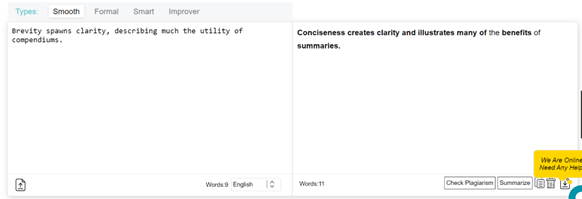
No, paraphrasing and summarizing are not the same thing. Paraphrasing means rephrasing a piece of text with different words but the same meaning while summarizing means shortening a piece of text to convey the main core points.
One of the best ways to summarize an article is:
Here is an excellent way to paraphrase an article:

